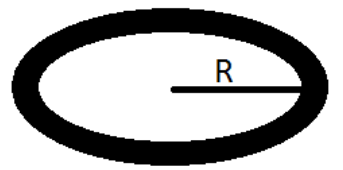
The radius of a ring is R and its coefficient of linear expansion is $\alpha $. If the temperature ring increases by$\theta $ then its circumference will increase by
A. $\pi {R^2}\alpha \theta $
B. $2\pi R\theta $
C. $\pi {R^{}}\alpha \dfrac{\theta }{2}$
D. $\pi {R^{}}\alpha \dfrac{\theta }{4}$
Answer
588k+ views
Hint – In such questions, we need to remember the basic concept of linear expansion of a rod on change in temperature and then convert the length into the circumference of the circle.
Formula used - $\dfrac{{\Delta L}}{L} = \alpha \Delta T$
Complete step-by-step solution -

The ring is generally metallic so when we heat the ring its diameter increases and its not only about a ring. If you heat a metallic disc its diameter increases and it becomes thick as well. This is the thermal expansion of the ring.
Given,
Radius of ring=R
Coefficient of linear expansion=$\alpha $
Temperature change=$\theta $
We know that, $L = 2\pi R$
$\dfrac{{\Delta L}}{L} = \alpha \Delta T$
$\dfrac{{\Delta L}}{L} = \alpha \Delta T$, this is the formula for linear expansion where $\Delta L\,{\text{and }}\Delta T$ is the change in length and change in temperature. This formula is helpful in most of the problems.
$
\Delta L = L\alpha \Delta T \\
= 2\pi R\alpha \Delta T = 2\pi R\theta \\
$
$ = 2\pi R\theta $
Hence the correct answer is $2\pi R\theta $.
Hence, the correct option is B.
Note - In such a type of question we must take care in the application of basic formula of linear expansion and good conceptual knowledge is also required for determining the change in the length of the ring. Doing this will solve your problem and will give you the right answer.
Formula used - $\dfrac{{\Delta L}}{L} = \alpha \Delta T$
Complete step-by-step solution -

The ring is generally metallic so when we heat the ring its diameter increases and its not only about a ring. If you heat a metallic disc its diameter increases and it becomes thick as well. This is the thermal expansion of the ring.
Given,
Radius of ring=R
Coefficient of linear expansion=$\alpha $
Temperature change=$\theta $
We know that, $L = 2\pi R$
$\dfrac{{\Delta L}}{L} = \alpha \Delta T$
$\dfrac{{\Delta L}}{L} = \alpha \Delta T$, this is the formula for linear expansion where $\Delta L\,{\text{and }}\Delta T$ is the change in length and change in temperature. This formula is helpful in most of the problems.
$
\Delta L = L\alpha \Delta T \\
= 2\pi R\alpha \Delta T = 2\pi R\theta \\
$
$ = 2\pi R\theta $
Hence the correct answer is $2\pi R\theta $.
Hence, the correct option is B.
Note - In such a type of question we must take care in the application of basic formula of linear expansion and good conceptual knowledge is also required for determining the change in the length of the ring. Doing this will solve your problem and will give you the right answer.
Recently Updated Pages
Master Class 11 Social Science: Engaging Questions & Answers for Success

Master Class 11 Physics: Engaging Questions & Answers for Success

Master Class 11 Maths: Engaging Questions & Answers for Success

Master Class 11 Economics: Engaging Questions & Answers for Success

Master Class 11 Computer Science: Engaging Questions & Answers for Success

Master Class 11 Chemistry: Engaging Questions & Answers for Success

Trending doubts
What is meant by exothermic and endothermic reactions class 11 chemistry CBSE

10 examples of friction in our daily life

One Metric ton is equal to kg A 10000 B 1000 C 100 class 11 physics CBSE

Difference Between Prokaryotic Cells and Eukaryotic Cells

1 Quintal is equal to a 110 kg b 10 kg c 100kg d 1000 class 11 physics CBSE

Draw a diagram of nephron and explain its structur class 11 biology CBSE




